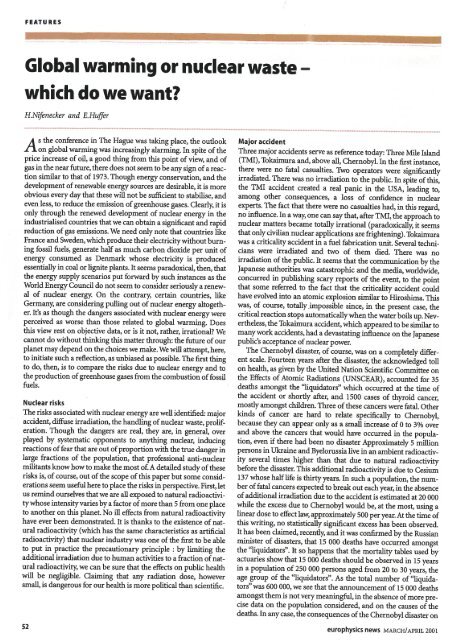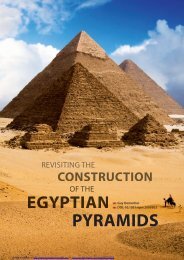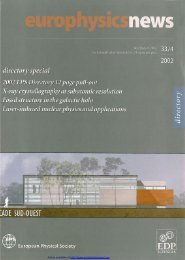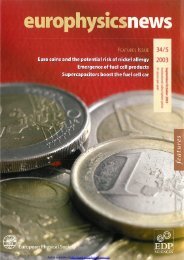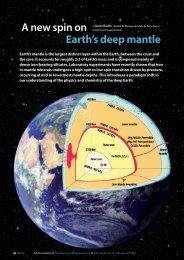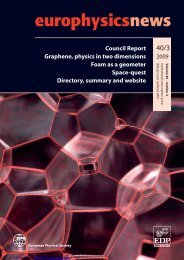Whole issue in PDF - Europhysics News
Whole issue in PDF - Europhysics News
Whole issue in PDF - Europhysics News
You also want an ePaper? Increase the reach of your titles
YUMPU automatically turns print PDFs into web optimized ePapers that Google loves.
.<br />
FEATURES<br />
, . -- .-- - - - .<br />
Global warm<strong>in</strong>g or nuclear waste <br />
which do we want?<br />
H.Nifenecker and E.Huffer<br />
As the conference <strong>in</strong> The Hague was tak<strong>in</strong>g place, the outlook<br />
on global warm<strong>in</strong>g was <strong>in</strong>creas<strong>in</strong>gly alarm<strong>in</strong>g. In spite ofthe<br />
price <strong>in</strong>crease of oil, a good th<strong>in</strong>g from this po<strong>in</strong>t ofview, and of<br />
gas <strong>in</strong> the near future, there does notseem to be anysign ofa reaction<br />
similar to that of 1973. Though energy conservation, and the<br />
development ofrenewable energysources are desirable, it is more<br />
obvious every day that these will not be sufficient to stabilise, and<br />
even less, to reduce the emission ofgreenhouse gases. Clearly, it is<br />
only through the renewed development of nuclear energy <strong>in</strong> the<br />
<strong>in</strong>dustrialised countries that we can obta<strong>in</strong> a significant and rapid<br />
reduction of gas emissions. We need only note that countries like<br />
France and Sweden, which produce their electricitywithoutburn<strong>in</strong>g<br />
fossil fuels, generate half as much carbon dioxide per unit of<br />
energy consumed as Denmark whose electricity is produced<br />
essentially<strong>in</strong> coal orlignite plants. It seems paradoxical, then, that<br />
the energy supply scenarios put forward by such <strong>in</strong>stances as the<br />
World Energy Council do not seem to consider seriouslya renewal<br />
of nuclear energy. On the contrary, certa<strong>in</strong> countries, like<br />
Germany, are consider<strong>in</strong>g pull<strong>in</strong>g out ofnuclear energy altogether.<br />
It's as though the dangers associated with nuclear energy were<br />
perceived as worse than those related to global warm<strong>in</strong>g. Does<br />
this view rest on objective data, or is it not, rather, irrational? We<br />
cannot do without th<strong>in</strong>k<strong>in</strong>g this matter through: the future ofour<br />
planet may depend on the choices we make. We will attempt, here,<br />
to <strong>in</strong>itiate such a reflection, as unbiased as possible. The first th<strong>in</strong>g<br />
to do, then, is to compare the risks due to nuclear energy and to<br />
the production ofgreenhouse gases from the combustion offossil<br />
fuels.<br />
Nuclear risks<br />
The risks associated with nuclear energyare well identified: major<br />
accident, diffuse irradiation, the handl<strong>in</strong>g ofnuclear waste, proliferation.<br />
Though the dangers are real, they are, <strong>in</strong> general, over<br />
played by systematic opponents to anyth<strong>in</strong>g nuclear, <strong>in</strong>duc<strong>in</strong>g<br />
reactions offear that are out ofproportion with the true danger<strong>in</strong><br />
large fractions of the population, that professional anti-nuclear<br />
militants know howto make the most of. A detailed studyofthese<br />
risks is, ofcourse, out ofthe scope ofthis paper but some considerations<br />
seem useful here to place the risks <strong>in</strong> perspective. First, let<br />
us rem<strong>in</strong>d ourselves that we are all exposed to natural radioactivitywhose<br />
<strong>in</strong>tensityvariesbya factor ofmore than 5 from one place<br />
to another on this planet. No ill effects from natural radioactivity<br />
have ever been demonstrated. It is thanks to the existence of natural<br />
radioactivity (which has the same characteristics as artificial<br />
radioactivity) that nuclear <strong>in</strong>dustry was one ofthe first to be able<br />
to put <strong>in</strong> practice the precautionary pr<strong>in</strong>ciple : by limit<strong>in</strong>g the<br />
additional irradiation due to human activities to a fraction ofnatural<br />
radioactivity, we can be sure that the effects on public health<br />
will be negligible. Claim<strong>in</strong>g that any radiation dose, however<br />
small, is dangerous for our health is more political than scientific.<br />
52<br />
Major accident<br />
Three major accidents serve as reference today: Three Mile Island<br />
(TMI), Tokaimura and, above all, Chernobyl. In the first <strong>in</strong>stance,<br />
there were no fatal casualties. Two operators were significantly<br />
irradiated. There was no irradiation to the public. In spite ofthis,<br />
the TMI accident created a real panic <strong>in</strong> the USA, lead<strong>in</strong>g to,<br />
among other consequences, a loss of confidence <strong>in</strong> nuclear<br />
experts. The fact that there were no casualties had, <strong>in</strong> this regard,<br />
no <strong>in</strong>fluence. In a way, one can saythat, after TMI, the approach to<br />
nuclear matters became totally irrational (paradoxically, it seems<br />
thatonlycivilian nuclear applications are frighten<strong>in</strong>g). Tokaimura<br />
was a criticality accident <strong>in</strong> a fuel fabrication unit. Several technicians<br />
were irradiated and two of them died. There was no<br />
irradiation of the public. It seems that the communication by the<br />
Japanese authorities was catastrophic and the media, worldwide,<br />
concurred <strong>in</strong> publish<strong>in</strong>g scary reports of the event, to the po<strong>in</strong>t<br />
that some referred to the fact that the criticality accident"could<br />
have evolved <strong>in</strong>to an atomic explosion similar to Hiroshima. This<br />
was, of course, totally.impossible s<strong>in</strong>ce, <strong>in</strong> the present case, the<br />
critical reaction stops automaticallywhen the water boils up. Nevertheless,<br />
the Tokaimura accident, which appeared to be similar to<br />
manywork accidents, had a devastat<strong>in</strong>g <strong>in</strong>fluence on the Japanese<br />
public's acceptance ofnuclear power.<br />
The Chernobyl disaster, of course, was on a completely different<br />
scale. Fourteen years after the disaster, the acknowledged toll<br />
on health, as given bythe United Nation Scientific Committee on<br />
the Effects of Atomic Radiations (UNSCEAR), accounted for 35<br />
deaths amongst the "liquidators" which occurred at the time of<br />
the accident or shortly after, and 1500 cases of thyroid cancer,<br />
mostly amongst children. Three ofthese cancers were fatal. Other<br />
k<strong>in</strong>ds of cancer are hard to relate specifically to Chernobyl,<br />
because they can appear only as a small <strong>in</strong>crease of 0 to 3% over<br />
and above the cancers that would have occurred <strong>in</strong> the population,<br />
even if there had been no disaster Approximately 5 million<br />
persons <strong>in</strong> Ukra<strong>in</strong>e and Byelorussialive <strong>in</strong> an ambient radioactivity<br />
several times higher than that due to natural radioactivity<br />
before the disaster. This additional radioactivity is due to Cesium<br />
137 whose halflife is thirty years. In such a population, the number<br />
offatal cancers expectedto break out eachyear, <strong>in</strong> the absence<br />
ofadditional irradiation due to the accident is estimated at 20 000<br />
while the excess due to Chernobyl would be, at the most, us<strong>in</strong>g a<br />
l<strong>in</strong>ear dose to effect law, approximately 500 peryear. At the time of<br />
this writ<strong>in</strong>g, no statistically significant excess has been observed.<br />
It has been claimed, recently, and it was confirmed by the Russian<br />
m<strong>in</strong>ister of disasters, that 15 000 deaths have occurred amongst<br />
the ''liquidators''. It so happens that the mortality tables used by<br />
actuaries show that 15 000 deaths should be observed <strong>in</strong> 15 years<br />
<strong>in</strong> a population of250 000 persons aged from 20 to 30 years, the<br />
age group of the "liquidators". As the total number of "liquidators"<br />
was 600 000, we see that the announcement of 15 000 deaths<br />
amongst them is notverymean<strong>in</strong>gful, <strong>in</strong> the absence ofmore precise<br />
data on the population considered, and on the causes of the<br />
deaths. In anycase, the consequences ofthe Chernobyl disaster on<br />
europhysics news MARCH/APRIL 2001


